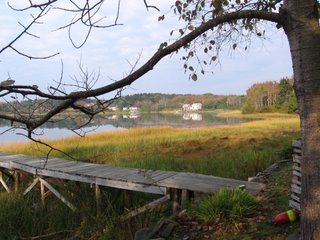
Our Cabin from across the bay


Salt Marsh
September 15, 2006
Annie is in Texas. Her father (Papa) is ill and tired, tired of living in a body that has worn out.
In the last four months, Annie and I have spent more time alone together (I know; I am leaving out Elmo) than any other time in our forty plus years of marriage. I have always loved her, but I like her now more than I ever have. I miss her already. Elmo misses her also, but then he misses her when she goes into the bathroom and closes the door. He and I are doing our best to take care of each other.
I will write about Papa, but I am not yet ready to do so.
In front of me, just out the window, across the deck and at the foot of the wall of stacked rocks is a salt marsh. I don’t know much about a salt marsh. We don’t have a lot of salt marshes around Denton or in the Colorado mountains where I have done most of my wandering. I heard a salt marsh expert on NPR say that salt marshes were critical to the entire ocean ecosystem and the air that we breathe; something to do with microorganisms. He also said that many of our salt marshes were dying and that they really didn’t yet know why.
Our salt marsh looks healthy. It may be best that I know so little. If I knew a lot, I would put the names on the paper and move on. But since I have no names I must watch it, feel it, smell it, hear it and get to know it so that I can write you a picture. Whether it is a bird, a flower, a tree or a person; we so often stop with the name. There is more to everything than the name.
The Bathtub Cove salt marsh spends part of most days submerged in salt water.
September 29, 2006
Salt Marsh Continued
I had to go to Denton; Papa was dying.
We came back to Bathtub Cove yesterday; after the struggle ended and Papa died, after the funeral home came and picked up that part of Papa that we thought was him and know now that it was not, after Hospice left; after grand kids came in from Colorado, Washington, San Marcos, Maine, and Alaska; after the stories and barbecue and potato salad and old black and white pictures from WWII; after the tears and hugs and laughter; after the decisions, the cemetery, the flowers; after the funeral--after saying good-by.
The salt marsh is till out side the window, a little more yellow. The sea grass that grows in the middle part of the marsh and that, before we left, looked like combed ducktails from 1957 now lies flat on the mud in yellow brown and green waves, east to west. I watch the tide come in and watch it go out again. I suppose that I should add, “from the dock of the bay.” It is raining today and the wind blows down the cove and slings rain drops against the windows.
A great blue heron lands in the thick pointy grass that still stands stiff and tall in front of the fallen wavy grass. Sea water covers the grass roots and the heron’s feet. The heron waits, frozen like a statute of herself, for a fish to swim into the grass. Her long neck, small head and pointy beak flash like an arrow released from the bow and the fish that had just eaten a tiny crab dies in the beak of the heron. Cormorants like a convoy of miniature submarines with periscopes raised float by, dive, and pop to the surface. The school of tiny fish they chase sprinkle the surface like a handful of gravel thrown from the dock. Some of the fish feed the Cormorants.
Yellow and brown leaves fallen from the cottonwoods and paper birch stick to planks on the porch in front of the windows and litter the small yard off the end of the house. The goldenrod blooms are dirty brown and sad, and a storm that came to the cove while we were gone blew down an old cottonwood in the forest behind the house.
I wait and watch the water and the birds. The tide comes in; bathtub Cove is full. The wind drives waves toward our rocks and dries the planks on the deck. A paper birch leaf blows against the glass, and a monarch flutters by ignoring the wind. The clouds break. Sun light sparkles the wave tops. Down the street wild asters bloom like lavender mist drifting next to the road. The leaves on some of the sugar maples look like hanging campfire coals swished by an unexpected wind. A flock Canada geese honking fly over Bathtub cove in a lopsided V, and Annie comes in the back door humming; carrying a pot of chrysanthemums swathed in bronze blooms.




















